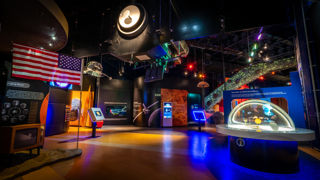
Goodbye to the Outer Solar System
- 27th Aug 2025
- Author: Dan Kendall
Scientists recently discovered a new moon orbiting Uranus – taking the count to 29 moons orbiting the Solar System’s funniest planet. As Curator of the National Space Centre, I should be excited. I should be amazed at the way the James Webb Space Telescope is shining a light on the darkest recesses of the Solar System. Metaphorically, before anyone writes in. Instead, what I actually did was let out a sigh and think, ‘oh well, that’s another part of the Our Solar System gallery out of date!’
You see, that’s the problem with a visitor attraction dedicated to space – scientists will keep coming along and making discoveries. Pesky scientists, doing science. If I worked at a Roman pottery museum, it’s unlikely that someone is going to discover that there was a part of the Roman empire that we didn’t even know existed. Unless we discover Atlantis. But I’m getting off track. The important thing is that our knowledge of the Solar System (and space in general) is always evolving – and that is exciting. Unless you have to get new graphics printed to keep up. Or stick a sticker over the number of moons a planet has, just to keep pace.
We opened the Space Centre in 2001. It was a different time. iPods were all the rage, people were wondering who had shot Phil in Eastenders and listening to Hear’Say, and Tecwen Whittock was coughing his way through an episode of Who Wants to be a Millionaire. And Jupiter had 28 moons. It’s now into the nineties. Of course, it’s not that the giant planets in our Solar System are kleptomaniacs with a serious moon habit, they’re not actively acquiring new ones. Although, that can happen – see Neptune’s moon Triton, which scientist believe is a captured Kuiper Belt object. Instead, the numbers keep going up as our ability to spot them improves. And we expect to find a lot more, because – read in a Brian Cox voice – the Outer Solar System is a complicated and dynamic place.
This (finally) brings me to why I’m writing this blog – we are closing our Solar System gallery. Not because we’ve given up trying to keep up with scientists and their discoveries. No, no, it is because we are building a new better one! Arriving in 2026 the Space Centre will be re-opening its Our Solar System gallery and things will have changed. Everything beyond Mars will be brand new, with some fun changes in the Inner Solar System section too. Gone will be graphics telling you how many moons Uranus has – either up-to-date or out-of-date. Gone will be the iconic Bean Can interactive, looking at the pull of gravity on different planets. Gone will be Saturn sitting in a bathtub. And gone will be this duck too.
Not everyone at the Space Centre is delighted the old gallery is closing. Although that is almost entirely due to an almost unhealthy attachment to the Bean Can interactive – people have actually asked me if they can have them when we remove them! But, I can promise them (and you) that what is coming will be much better!
Back when the gallery first opened in 2001, visitors probably had a Nokia 3310 in their pocket. And whilst those phones probably still have charge today, they couldn’t access the internet the way modern phones do. Today’s visitors have access to a wealth of information about the Solar System – they can even look up how many moons Uranus has themselves. This means that our plans for the new gallery can be more ambitious. We’ll still tell you the basics, but digital technology (screens!) will allow us to keep up-to-date with those curious scientists. If a planet gets a new moon, we’ll be on it. Meanwhile, we can build new exhibits that explore in greater depth the wild and majestic world of the Outer Solar System (Brian Cox voice, again!). But you’ll have to come back in 2026 to see it!
As I say goodbye to the old Our Solar System gallery, there is one scientific certainty I keep returning to. That is that Planet 9 will be discovered on the very day we re-open. Planet 9 is the theorised ninth planet out far beyond the orbit of Neptune. We don’t know for sure that it is there – but some scientists believe that the weird orbits of some objects in the Outer Solar System suggests that there is a large planet out there, pushing and pulling these objects. We don’t know for certain, it is very much up for debate. But I know. I know, because that’s just the way the world works. The National Space Centre will open a new Solar System gallery next year, and within hours of opening those pesky scientists will get in touch, “oh, by the way – there’s now nine planets, not eight”. Bookmark this blog. It. Will. Happen.
So, farewell to the Our Solar System gallery. And the Bean Cans.





